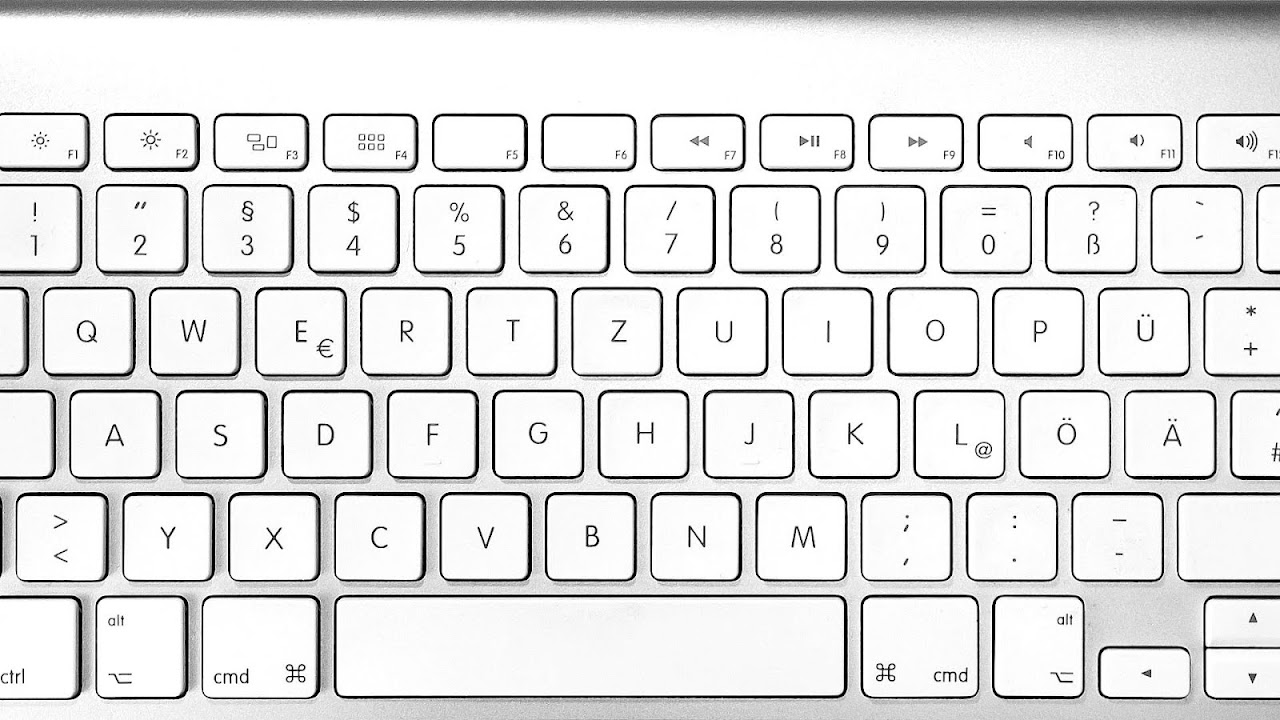
The German keyboard layout is a QWERTZ keyboard layout commonly used in Austria and Germany. It is based on one defined in a former edition (October 1988) of the German standard DIN 2137-2. The current edition DIN 2137-1:2012-06 standardizes it as the first (basic) one of three layouts, calling it "T1" (Tastaturbelegung 1, "keyboard layout 1").
The German layout differs from the English (US and UK) layouts in four major ways:
- The positions of the "Z" and "Y" keys are switched. A possible reason is that to enable German manufacturers to circumvent patents which included the QWERTY layout, at least one position had to be changed, which could be achieved by moving the "Z" (which is a much more common letter in German than the "Y") to a more prominent location.
- Part of the keyboard is adapted to include umlauted vowels (ä, ö, ü).
- Some of special key inscriptions are changed to a graphical symbol (e.g. ? Caps Lock is an upward arrow, <- Backspace a leftward arrow). Most of the other abbreviations are replaced by German abbreviations (thus e.g. "Ctrl" is translated to its German equivalent "Strg", for Steuerung). "Esc" remains as such. (See: "Key labels" below)
- Like many other non-American keyboards, German keyboards change the right Alt key into an Alt Gr key to access a third level of key assignments. This is necessary because the umlauts and some other special characters leave no room to have all the special symbols of ASCII, needed by programmers among others, available on the first or second (shifted) levels without unduly increasing the size of the keyboard.

Maps, Directions, and Place Reviews
General information
The characters ², ³, {, [, ], }, \, @, |, µ, ~ (and, since the late 1990s, EUR) are accessed by holding the AltGr key and tapping the other key. The Alt key on the left will not access these additional characters. Alternatively Ctrl+Alt and pressing the respective key also produce the alternative characters on some operating systems.
The accent keys ^, ', ' are dead keys: press and release an accent key, then press a letter key to produce accented characters (ô, á, ù, etc.; the current DIN 2137-1:2012-06 extends this for e.g. ?, ? etc.). If the entered combination is not encoded in Unicode by a single code point (precomposed character), most current implementations cause the display of a free-standing (spacing) version of the accent followed by the unaccented base letter. This behavior (which is explicitly not compliant with the current DIN 2137-1:2012-06) leads some users suffering from insufficient typing skills to mistype a spacing accent instead of an apostrophe (e.g., it's or it's instead of correctly it's).
Note that the semicolon and colon are accessed by using the ? Shift key.
The "T1" layout lacks some important characters like the German-style quotation marks (" " and , '). As a consequence, these are seldom used in Internet communication, usually replaced by " and '.
The "T2" layout newly defined in DIN 2137-1:2012-06 was designed to overcome such restrictions, but firstly to enable typing of other languages written in the Latin script. Therefore, it contains several additional diacritical marks and punctuation characters, including the full set of German, English, and French-style quotation marks in addition to the typographic apostrophe, the prime, the double prime, and the ?okina.
The image shows characters to be entered using AltGr in the lower left corner of each key depiction (characters not contained in the "T1" layout are marked red). Diacritical marks are marked by a flat rectangle which also indicates the position of the diacritical mark relative to the base letter. The characters in shown at the right border of a keytop are accessed by pressing a special key combination before; for those marked green the corresponding capital letter is available by pressing the Shift key simultaneously.
In addition, DIN 2137-1:2012-06 defines a layout "T3", which is a superset of "T2" incorporating the whole "secondary group" as defined in ISO/IEC 9995-3:2010. Thus, it enables to write several minority languages (e.g. Sami) and transliterations, but is more difficult to comprehend than the "T2" layout, and therefore not expected to be accepted by a broad audience beyond experts who need this functionality.
Key labels
Contrary to many other languages, German keyboards are usually not labeled in English (in fact, DIN 2137-1:2012-06 requires either the symbol according to ISO/IEC 9995-7 or the German abbreviation is to be used, with "Esc" as an exception). The abbreviations used on German keyboards are:
On some keyboards - including the original IBM PC/AT (and later) German keyboards - the asterisk (*) key on the numeric keypad is instead labeled with the multiplication sign (×), and the divide-key is labeled with the division sign (÷) instead of slash (/). However, those keys still generate the asterisk and slash characters, not the multiplication and division signs.
Caps lock
The behaviour of ? Caps Lock according to former editions of the DIN 2137 standard is inherited from mechanical typewriters: Pressing it once shifts all keys including numbers and special characters until the ? Caps Lock key is pressed again. Holding ? Shift while ? Caps Lock is active unshifts all keys. Both ? Shift and ? Caps Lock lack any textual labels. The ? Caps Lock key is simply labeled with a large down-arrow (on newer designs pointing to an uppercase A letter) and ? Shift is labeled with a large up-arrow. The current DIN 2137-1:2012-06 simply requests the presence of a "capitals lock" key (which is the name used in the ISO/IEC 9995 series), without any description of its function.
In IT, an alternative behaviour is often preferred, usually described as "IBM", which is the same as ? Caps Lock on English keyboards - only letters are shifted, and hitting ? Caps Lock again releases it.
German Keyboards Video
History
Source of the article : Wikipedia


EmoticonEmoticon